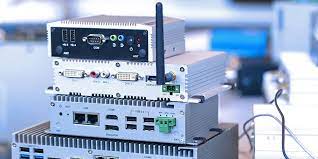
Welcome to the fascinating world of rugged embedded computing! In today’s digital age, where technology is constantly advancing and innovation knows no bounds, it’s important to have devices that can withstand even the harshest of environments. That’s where rugged embedded computing comes into play. But what exactly does it mean? What sets these devices apart from their conventional counterparts? And how are they revolutionizing various industries? Get ready to embark on a journey as we explore the ins and outs of rugged embedded computing, its history, advantages, challenges, applications, industry trends, and a glimpse into its promising future. So fasten your seatbelts as we dive deep into this exciting realm where durability meets cutting-edge technology!
What Makes a Device Rugged?
Durability and resilience are the defining characteristics of rugged devices, distinguishing them from regular counterparts that falter under extreme conditions such as harsh temperatures, vibrations, shocks, humidity, dust, and water ingress. The construction of rugged devices is important, featuring robust casings made from materials like toughened plastics or metal alloys. These materials absorb impact without compromising functionality, providing protection against accidental drops or bumps.
Sealing techniques, like gaskets or O-rings, are employed to prevent dust and moisture from compromising sensitive components, making rugged devices particularly suitable for outdoor environments. Another important aspect of achieving ruggedness is the device’s ability to operate across a wide temperature range. Rugged embedded computing systems utilize advanced cooling mechanisms, such as heat sinks or fans, to dissipate excess heat generated by powerful processors.
Internal components, including hard drives and memory modules in rugged devices, incorporate shock-resistant technologies to ensure data integrity even in the face of severe vibrations or sudden impacts. Beyond physical durability, rugged devices excel in connectivity, equipped with multiple ports for various peripheral connections like Ethernet ports for network connectivity or serial ports for communication with external equipment. In summary, a true “rugged” device stands out in adverse conditions due to its sturdy construction materials, protective seals against environmental factors, efficient cooling mechanisms, shock-resistant technology safeguarding internal components, and versatile connectivity options. This versatility makes them reliable not only in military deployments on the battlefield but also in industrial settings facing challenging circumstances.
The History of Rugged Embedded Computing
The history of rugged embedded computing traces back several decades, originating in the military and aerospace sectors’ need for reliable systems in harsh conditions. World War II highlighted the importance of rugged computers for important calculations, despite their initial large and bulky nature.
Over the years, technological advancements led to the evolution of rugged embedded computing.
Miniaturization trends resulted in smaller yet high-performance systems, finding applications across diverse industries such as transportation, manufacturing, energy exploration, and healthcare. Engineers faced and overcame challenges, including temperature extremes, vibration resistance, and shock protection, driving the development of more resilient solutions.
Today’s rugged embedded computing devices are advanced engineering marvels, designed to operate reliably in extreme temperatures (-40°C to 85°C) and withstand high vibration levels.
They feature enhanced protection against dust and water ingress, making them suitable for outdoor environments. The evolution of rugged embedded computing responds to both technological progress and market demands. Industries relying on automation and the growing importance of digitalization drive the need for robust systems capable of handling complex tasks in challenging circumstances.
As we enter an era dominated by IoT connectivity and the integration of edge computing into daily life, from smart cities to autonomous vehicles, the demand for even more durable and powerful embedded computers is expected to rise.
Advantages of Rugged Embedded Computing
Rugged embedded computing offers several advantages that make it a preferred choice in various industries.
- Harsh Environment Endurance: Rugged embedded computing excels in harsh environments, demonstrating resilience against extreme temperatures, vibrations, and moisture. This robustness ensures reliable operation in challenging conditions.
- Durability and Long Lifespan: These devices are constructed with durability in mind, featuring high-quality components and robust designs. The result is a long lifespan, reducing the need for frequent replacements and contributing to cost savings over time.
- Enhanced Security Features: Rugged embedded computers prioritize security with features such as encryption capabilities and secure boot options. This ensures the protection of sensitive data against unauthorized access.
- Customizability: Rugged devices are highly customizable to meet specific industry requirements. Their modular designs and flexible configurations allow for seamless adaptation to various applications.
- Reliable Connectivity: Rugged embedded computing offers a range of connectivity options, including Wi-Fi, Bluetooth, cellular networks, and Ethernet ports. This facilitates seamless communication between devices within a network or across multiple locations.
- Power Efficiency: Optimized hardware design and efficient software management systems contribute to excellent power efficiency in rugged embedded devices. They consume less power compared to traditional computing systems while maintaining high performance.
In conclusion, the advantages of rugged embedded computing encompass durability, security, customizability, and power efficiency. These features make rugged devices well-suited for industries where reliable performance in challenging environments is important. The ability to withstand harsh conditions and provide long-term reliability positions rugged embedded computing as a preferred choice across various sectors.
Applications of Rugged Embedded Computing
Rugged embedded computing has become indispensable across various industries, showcasing its resilience in harsh environments and reliable performance. Here’s a glimpse into key sectors where it’s making a significant impact:
- Defense and Aerospace: Important for military communication systems and UAVs, rugged embedded computers excel in extreme conditions encountered in defense and aerospace operations.
- Industrial Automation: Important in controlling machinery and monitoring processes on factory floors, rugged embedded computers ensure reliable operation even in dusty or high-temperature settings.
- Transportation: For efficient transportation network management, rugged computing powers real-time monitoring, navigation controls, and passenger information displays.
- Energy Sector: Essential for oil rigs, wind farms, and power plants, rugged embedded computers handle extreme conditions, enabling uninterrupted performance through remote monitoring and data analysis.
- Medical Equipment: In medical settings, ruggedized computers support diagnostic imaging, surgical equipment, and patient monitoring systems, enduring sterilization procedures and fluctuating temperatures.
- Outdoor IoT Applications: important for agriculture, mining, fleet management, natural resource exploration, and smart cities, rugged embedded computing ensures continuous connectivity, data acquisition, and analysis in challenging outdoor environments without compromising performance or reliability.
Trends in the Rugged Computing Industry
As technology continues to advance at an unprecedented pace, the rugged computing industry is also evolving to meet new demands and challenges.
- Compact and Lightweight Devices: Advancements in miniaturization and materials science are driving the demand for smaller yet more robust rugged devices capable of withstanding harsh environments.
- Integration of Wireless Connectivity: The industry is witnessing the integration of wireless connectivity into rugged embedded computers, enabling real-time data transfer and remote monitoring. This trend is particularly beneficial for industries like transportation, logistics, and agriculture.
- Cybersecurity Emphasis: With increased interconnectivity, there is a growing emphasis on cybersecurity in rugged computing systems. Manufacturers are implementing advanced encryption protocols and secure operating systems to protect sensitive data from unauthorized access.
- Rising Interest in Edge Computing: Edge computing is gaining prominence, involving processing data closer to its source. This approach reduces latency and enables quicker decision-making, especially in time-sensitive applications like autonomous vehicles and industrial control systems.
- Sustainability Efforts: Sustainability has become an important consideration, leading to the design of more energy-efficient devices with longer battery life. Manufacturers are also working to minimize waste during production processes.
- Integration of Artificial Intelligence: Artificial intelligence is making its way into rugged embedded computers through machine learning algorithms. This integration enables predictive maintenance capabilities by analyzing sensor data to detect potential failures before they occur.
In conclusion, the future of rugged embedded computing is characterized by ongoing innovation and adaptation to customer needs. The industry’s trajectory is marked by trends such as compactness, wireless connectivity, cybersecurity measures, edge computing, sustainability efforts, and the integration of artificial intelligence. These advancements position the rugged computing industry for continued growth and relevance across diverse sectors.
Conclusion
In conclusion, rugged embedded computing stands as a transformative force in navigating challenging environments, demonstrating its resilience across sectors from the military to healthcare. With enhanced reliability and durability, these devices overcome design challenges through continuous technological innovation. Trends point towards a desire for smaller, more powerful devices and increased IoT connectivity for real-time analysis.
The future promises further advancements with improved processing power and advanced materials, reinforcing rugged embedded computing as an important solution across industries. As technology evolves, the anticipation is for even more potent and compact solutions tailored to meet the demands of diverse and demanding applications.



